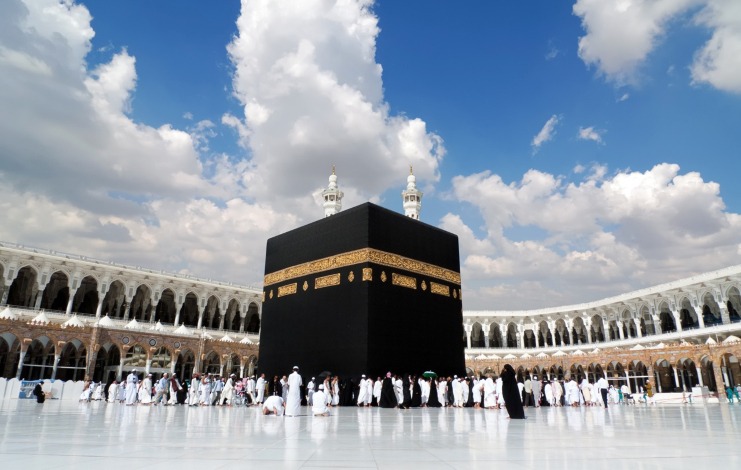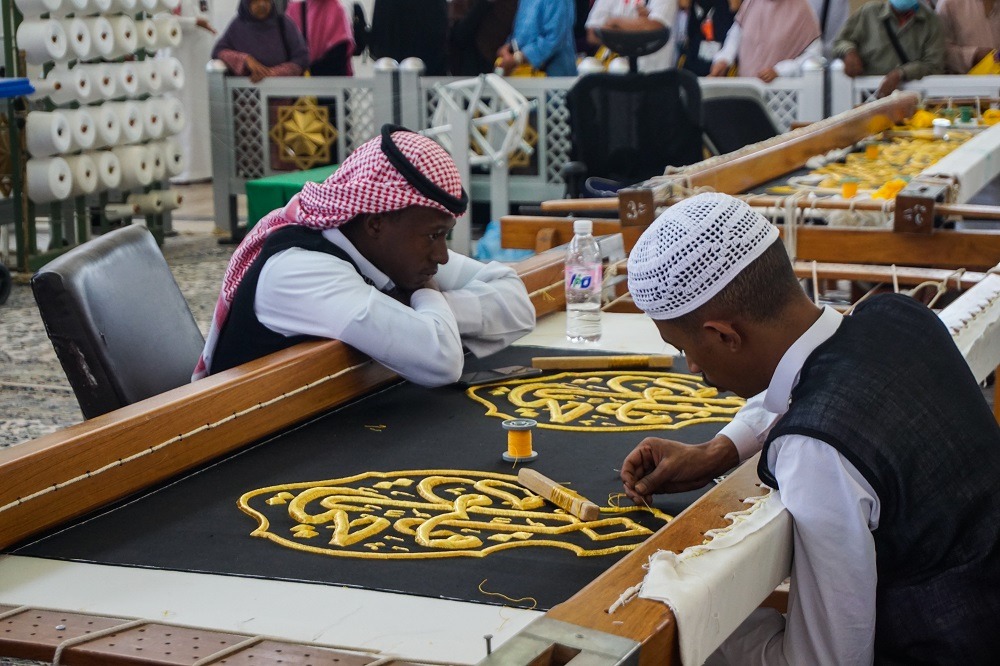Last Saturday, the most sacred Islamic site, the Kaaba, in the Grand Mosque in Mecca, Saudi Arabia, got a new covering to signal the start of a new Islamic year.
The ornately embroidered covering, called Kiswah in Arabic, is usually changed every year in Dhu Al-Hijjah, in the Islamic calendar, but that changed this year as per a royal decree, according to The National News.
This situation got us wondering, what’s the history behind the Kiswah? Why was it put there? And why is it black?
The Kaaba
Before we get into the Kiswah, let’s first talk about the Kaaba; the most sacred structure in the Islamic religion, as Muslims around the world pray in its direction, considering it the House of God.
Believed to have been built by the Prophets Ibrahim and Ismail. The structure is presided over by the President of the Affairs of the Two Holy Mosques, which are The Grand Mosque in Mecca and The Prophet’s Mosque in Medina.

The Kaaba has been draped for over a thousand years to protect it from the elements as well as a way to show reverence and veneration; this Kiswah usually gets changed annually during the Hajj season to welcome the pilgrims arriving at the site.
The History Behind The Kiswah
While we see the structure today draped in a black cloth made of several textiles, that wasn’t always the case.
The First Kiswa
According to several stories, before the rise of Islam in the Arabian peninsula, the King of Yemen, Tubba Abu Karab of Himyar, was the first to provide a covering for the structure.
Some stories state that the cover was a white cover with red stripes, while others mention that it was just white to symbolize the site’s purity. Either way, from that moment onward, the Kaaba had a cover since King Tubba’s successors took the gesture as a religious duty after him.
Pre-Prophet Muhammad’s Reign
During Tribe Quraish’s control of the city, they denied the Prophet Muhammed access to the site, and he or his followers weren’t allowed to have the honor of offering a cover to drape the Kaaba along with the other tribes, but all that changed a few years later.
Keeping The Status Quo
In 630 AD, The Prophet and the Muslims took the city peacefully, and despite them having control for the first time, the Kiswah wasn’t changed and left as is. Unfortunately, that changed when someone was lighting incense near the Kaaba and accidentally set the cover on fire, leading to the need for it to be replaced.
Different Rulers, Different Colors
Once the previously mentioned fire had damaged the Kiswah, it needed replacing, leading to the Prophet getting a new one from Yemen, which was white with red stripes.
During the Rashidon Caliphate, Abu-Bakr El-Seddik kept the tradition while keeping the same colors. On the other hand, Omar Ibn-Al-Khattab and Uthman Ibn-Affan changed the color to just white, using a cloth called “qubati” made by Copts in Egypt, hence the name.
From that moment forward, the colors and the textiles of the Kiswah changed over time according to who claimed suzerainty of the area, leading to all kinds of changes.
Some stories state that during the reigns of Muawiyah ibn-Abi-Sufyan and Abdullah ibn-Al-Zubair, the Kiswah used to be changed twice a year; the first was with a red brocade on the Day Of Ashura, and the other was with a qubati at the end of Ramadan.
During the Abbasid Caliphate, the seventh Caliph, Al-Ma’moun, took it up a notch, changing the Kaaba’s Kiswa three times a year, a white qubati when a new moon was sighted in Rajab, a white brocade near the end of Ramadan, and finally a red brocade on the 8th of Dhul Hijjah.
There wouldn’t be a change in the Kiswah’s colors until the Abbasid Caliph Al-Nasir (1180 – 1225 AD), who ordered that it would be royal-green in color; however, one year before the end of his reign, it would finally change one last time into black, staying that way to this day.
Who Made The Kiswah?
The makers and artisans who made the Kiswah changed hands over time, with Yemen and Egypt being the most prominent contributors; others include Turkey and Syria. That said, during the 13th century, Egypt took control, almost exclusively, in its creation using textiles imported from Iraq, India, Sudan, and more.

By the early 19th century, the focus on the creation of the Kiswah in Egypt was at an all-time high, with Muhammad Ali Pasha establishing a factory for it in 1817, in the Khoronfesh quarter in Cairo. The institution only had the most skilled craftsmen and calligraphers from all over the country perfecting the design, craft, and inscriptions on the Kiswah. Once done, the Kiswah was displayed for everyone to admire before sending it by a caravan called “Al-Mahmal” to Mecca.

Later on, in the early 19th century, Saudi Arabia and Egypt shared the responsibility of manufacturing the Kiswah before Saudi Arabia took over completely in 1961.
Since 1972, the manufacturing of the Kiswah has been done in the Umm Al-Joud district, Mecca, where it still is today. However, as technology evolved, the Kiswah’s creation is done with the help of computer technology along with master craftsmen from the region.
Things You Might Not Have Known About The Kiswah
The Kiswah is made from some of the best materials in the world, which include over 670 kgs of black silk along with 220 kgs of silver and gold threads for embroidering the Quranic verses.
As you might have estimated, this makes it really expensive, and while the costs may vary, the Keswah can reach up to six million dollars to make.

In the past, after the removal of the Kiswah every year, it would be cut into pieces and buried in an undisclosed desert location; However, that changed, now, the old one is cut into pieces which are given away as gifts to dignitaries and high-profile visitors.
Most rulers moved away from the color white, due to it easily becoming dirty, especially after the pilgrim’s visit during the hajj.
We Said This: Don’t forget… The Hajj Through Art And Objects From Around The World



